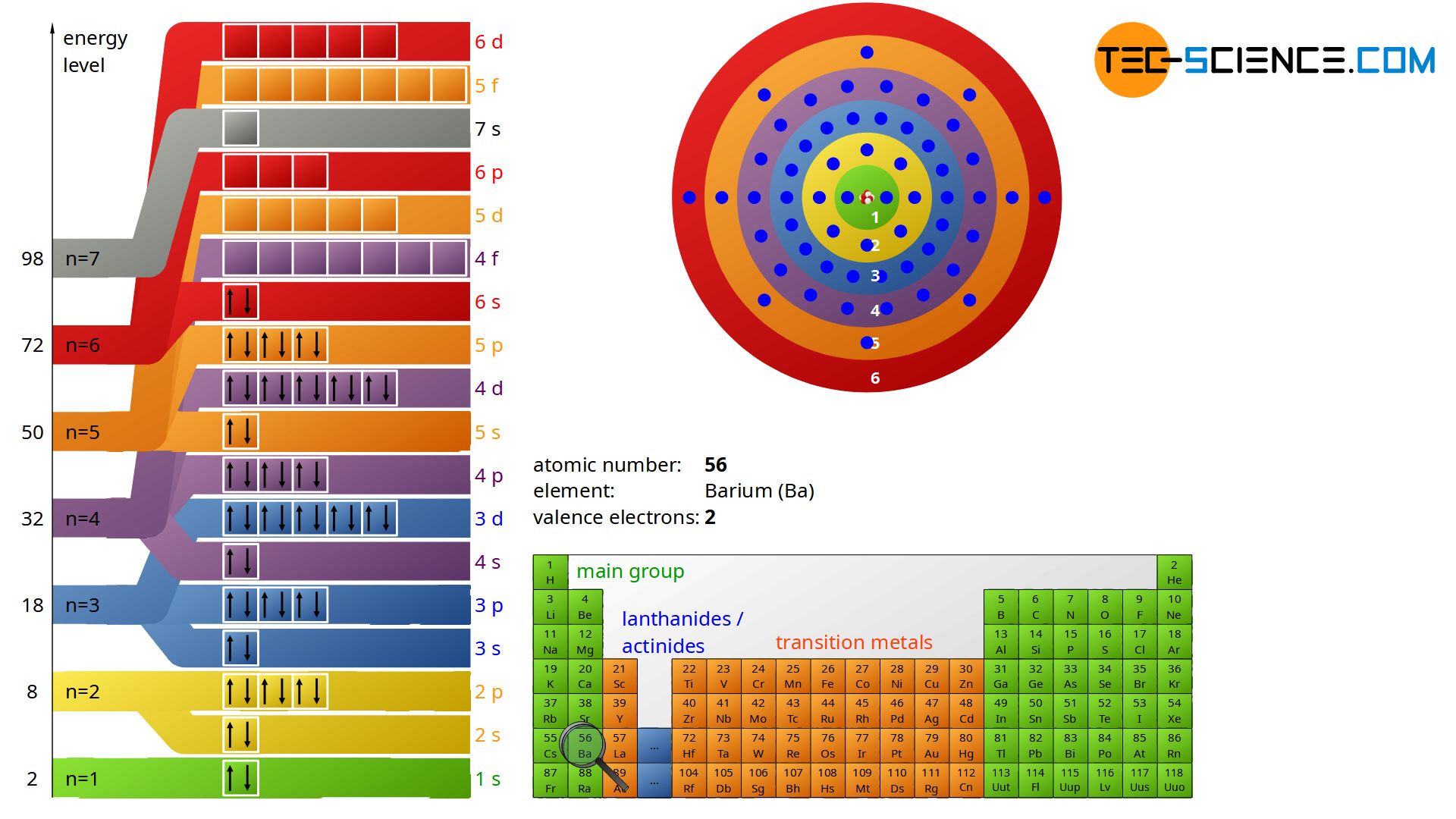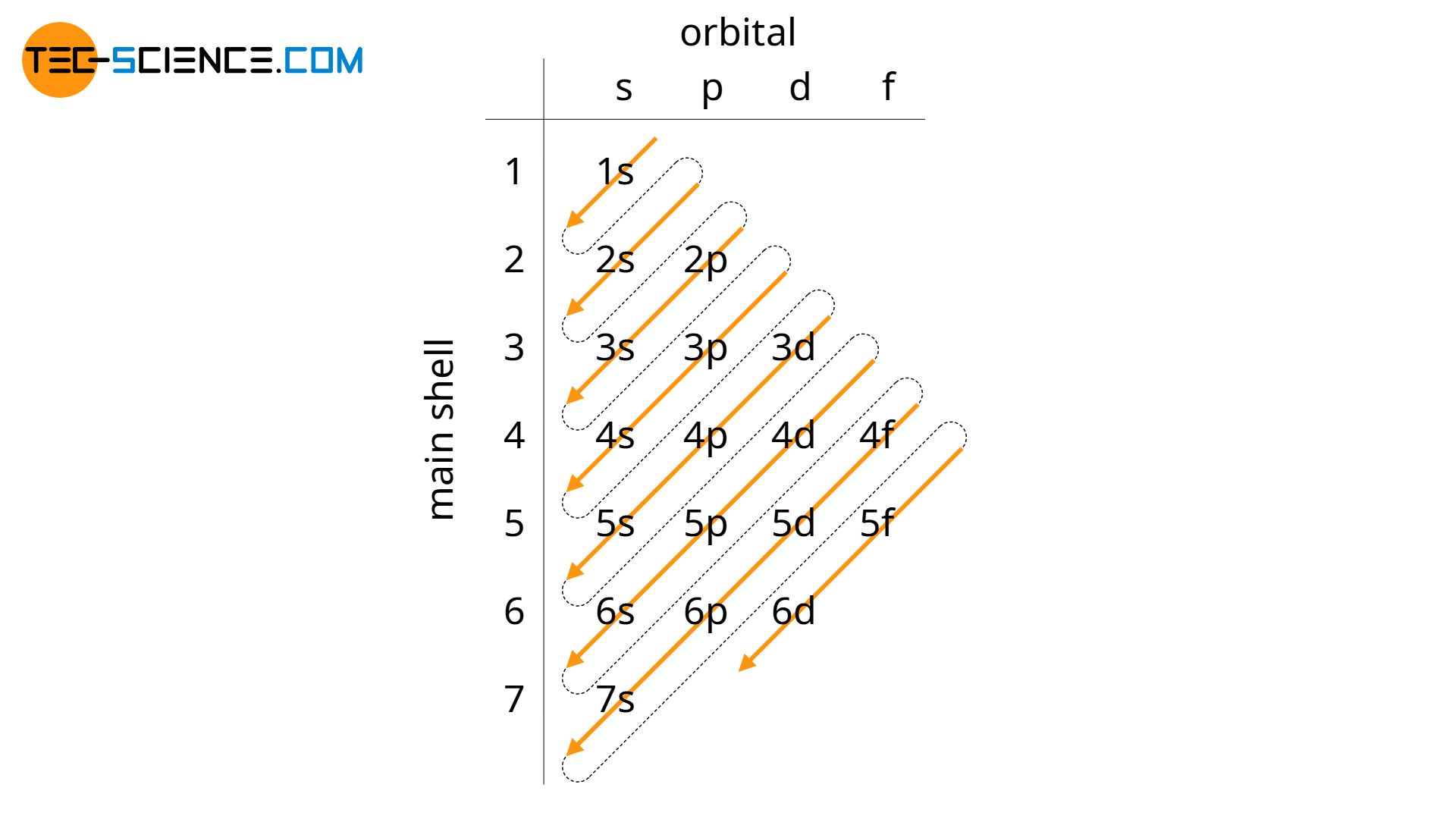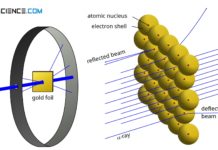The Bohr-Sommerfeld model is an extension of the Bohr model. It explains the distribution of electrons within the shells.
The weaknesses of the Bohr model could be partially eliminated by the physicist Arnold Sommerfeld. In addition to the already introduced shells by Bohr, Sommerfeld further introduced subshells (also referred to as orbitals). With the introduction of these subshells, it was finally possible to explain the distribution of the electrons within the shells. The distribution of electrons in an atom is referred to as electron configuration. It will be explained in more detail below.

One imagines the main shells introduced by Bohr subdivided into subshells. The number of subshells depends on the main shell. The number of the main shell indicates the number of subshells. In the figure above, not all subshells of the higher main shells are shown, as these usually have no relevance. The lower shells are not labeled with numbers but with lowercase letters (s, p, d and f). A g-subshell exists only for theoretical elements with atomic numbers greater than 121 (called superactinoids), which is why this orbital has only theoretical meaning.
1th main shell (K): 1 lower shell (s), identical to the main shell
2nd main shell (L): 2 lower shells (s, p)
3rd main shell (M): 3 lower shells (s, p, d)
4th main shell (N): 4 lower shells (s, p, d, f)
For example, the shell designation 3p means the subshell p (“2nd subshell”) of the third main shell and the designation 4s the subshell s (“1st subshell”) of the fourth main shell. The shell designation 2d, however, does not exist because the second main shell has only one s and one p subshell! Subshells can only be occupied by a certain number of electrons:
s-subshell: 2 electrons
p-subshell: 6 electrons
d-subshell: 10 electrons
f-subshell: 14 electrons
Here, a subshell of a lower main shell number may well have a higher energy level than the subshell of a higher shell number (Sommerfeld explained this with elliptical orbits of electrons instead of circular orbits after Bohr)! For example, the subshell 3d has a higher energy state than the subshell 4s! The graphical representation by shells with their subdivisions in subshells is therefore no longer possible. Instead atomic orbitals are used, which will not be discussed further here.
The energetic distribution of the shells is shown in the figure above. The subshells are divided into white-framed blocks, each providing space for a total of two electrons.
In order to better remember the energetic order of the orbitals, you can first create a table. Therein, the line numbering corresponds to the main shell number and the column numbering corresponds to the subshell. Thus, the subshell with associated main shell is clearly defined for each field. The energetic order of the orbitals can now be obtained by going through the table diagonally line by line from top right to bottom left. This principle is also knows as the aufbau principle (“Aufbau” is a german word which means “configuration”).

The animation below shows the electron configuration with increasing atomic number of the atoms. Note that the number of electrons increases to the same extent as the number of protons and thus increases by one from element to element. The subshells belonging to a main shell are all marked in a uniform color. Also shown are the outer electrons (valence electrons) on the outermost main shell (valence shell), since these are decisive for the chemical behavior of an element. The animation also explains the order of the chemical elements in the periodic table.
The occupation of the shells with electrons always starts from the lowest energy state, only then are higher energy levels occupied. Each block of a subshell is initially filled with only one electron. This is symbolized by an ascending arrow. Only if all blocks of a subshell are solitary occupied by an electron, then the each block will be filled with one more electron. These second electrons are represented by a descending arrow. This symbolic distinction is due to the so-called Pauli exclusion principle of quantum mechanics. According to this principle no two identical electron states can exist. The different arrow directions take this principle into account (to be more precise: each arrow represents one of two spin quantum numbers).
The Pauli exclusion principle forbids that two electrons share the same state!
In the subshell 3p, it is striking that after it has been completely filled with electrons, it is energetically more favorable to start the fourth main shell and fill it with electrons (4s shell) instead of the subshell 3d! Note, that some subshells of a smaller main shell number are obviously of a higher energy level than subshells of a higher main shell number. Thus, the occupation of electrons of the main shells, which in the Bohr model at first appears a little bit strange, can now be explained.
Only after the 4s orbital is fully occupied, the third main shell is filled up with the energetically higher 3d orbital. This jump is also noticeable in the chemical behavior. It marks the transition from the so-called main group elements to the transition group (transition metals). The transition metals are characterized by the fact that each of them have an incompletely occupied d-orbital (called d-block)!

Another jump where even one main shell is being skiped can be seen in the transition from the element barium (Ba) to cerium (Ce). After the 6s orbital of barium has been completely filled, two main shells are “jumped back” and the 4f orbital is filled up (the lanthanum in between of those elements is an exception to the Aufbau principle). This jump introduces a subgroup of transition metals, called lanthanides or actinides (f-block). The lanthanides or actinides are characterized by the fact that the f-orbital is gradually filled with electrons! Strictly speaking, the elements lanthanum and actinium do not belong to the group of lanthanides or actinides, although they are very often counted for practical reasons (after all, the suffix “ide” means similar to). Therefore, these elements also fall into the f-block.
Depending on which orbital an electron is added to, one can divide the periodic table into blocks, which correspond to s-, p-, d- or f-block.
Note, that there are other exceptions to the aufbau principle, for example, for the metals copper and chromium. There, an electron changes from the 4s subshell to the 3d subshell and thus remains occupied by only one electron. Such exceptions to the regular principle can be found especially at higher atomic numbers, as the electrons influence each other more and more. In addition, relativistic effects come into play, which are not taken into account by this model.


